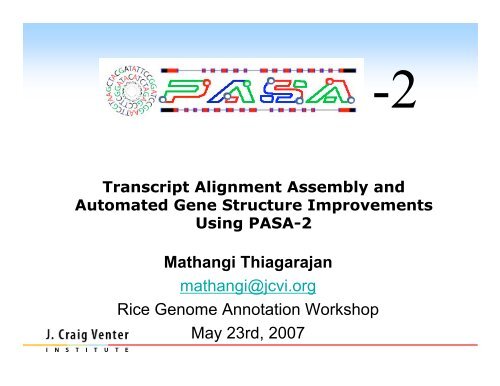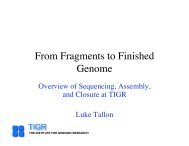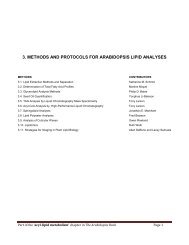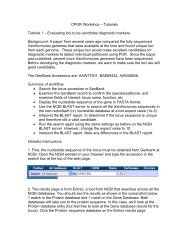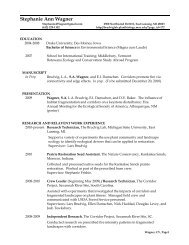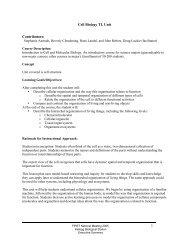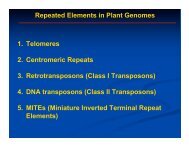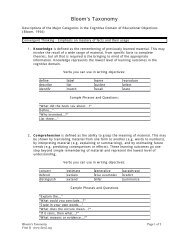PASA Pipeline - Rice Genome Annotation Project
PASA Pipeline - Rice Genome Annotation Project
PASA Pipeline - Rice Genome Annotation Project
Create successful ePaper yourself
Turn your PDF publications into a flip-book with our unique Google optimized e-Paper software.
-2<br />
Transcript Alignment Assembly and<br />
Automated Gene Structure Improvements<br />
Using <strong>PASA</strong>-2<br />
Mathangi Thiagarajan<br />
mathangi@jcvi.org<br />
<strong>Rice</strong> <strong>Genome</strong> <strong>Annotation</strong> Workshop<br />
May 23rd, 2007
About <strong>PASA</strong><br />
<br />
<strong>PASA</strong> is an open source free to download software<br />
program written by Brian Haas (bhaas@jcvi.org)<br />
<br />
Reference :Its original application is described in:<br />
Haas, B.J., Delcher, A.L., Mount, S.M., Wortman, J.R., Smith Jr,<br />
R.K., Jr., Hannick, L.I., Maiti, R., Ronning, C.M., Rusch, D.B., Town,<br />
C.D. et al. (2003) Improving the Arabidopsis genome annotation<br />
using maximal transcript alignment assemblies. Nucleic Acids Res,<br />
31, 5654-5666.
Topics Outline<br />
Overview of the <strong>PASA</strong> <strong>Pipeline</strong><br />
Alignment Assembly Algorithm<br />
<strong>Annotation</strong> comparison
FL-cDNAs and ESTs<br />
“Gold standard” for gene structure resolution<br />
• Introns and exons via spliced alignment<br />
Direct evidence for:<br />
• Alternative splicing<br />
• Untranslated regions (UTRs)<br />
• Polyadenylation sites
The <strong>PASA</strong> <strong>Pipeline</strong><br />
Automate incorporation of transcript alignments<br />
into gene structure annotations<br />
It was originally developed to refine gene<br />
structures in Arabidopsis as part of our<br />
Arabidopsis re-annotation effort.<br />
Since that time, we’ve expanded the pipeline and<br />
applied it to a range of other organisms at TIGR,<br />
now with a special focus on <strong>Rice</strong>.
Influxes of mRNA Sequences<br />
After Initial <strong>Genome</strong> Releases<br />
1000000<br />
human<br />
mouse<br />
Drosophila<br />
Arabidopsis<br />
100000<br />
Feb.2001<br />
Dec.2002<br />
10000<br />
Mar.2000<br />
1000<br />
Dec.2000<br />
1999 2000 2001 2002 2003 2004 2005 2006
Additionally Found Uses of <strong>PASA</strong><br />
Automated generation of training sets for Gene<br />
Finders (Aedes, Aspergillus, Tetrahymena)<br />
Evaluation of EST libraries (Tetrahymena)<br />
examine redundancy within EST library<br />
selection of clones for full-length sequencing<br />
Transitive gene structure annotation for closely<br />
related species (Aspergillus sp.)<br />
Comparing different annotation methods on the<br />
same contigs (Plasmodium vivax)<br />
Cataloging polyA sites for more detailed studies<br />
(Arabidopsis, <strong>Rice</strong>)
The <strong>PASA</strong> <strong>Pipeline</strong> [at a glance]<br />
Align transcripts to genome<br />
Assemble the alignments<br />
<strong>PASA</strong>: Program to Assemble Spliced Alignments<br />
Compare alignment assemblies to<br />
existing annotations, suggest updates
Transcript Sequences<br />
Seqclean<br />
Align to <strong>Genome</strong><br />
Cluster overlapping alignments<br />
<strong>PASA</strong> <strong>Pipeline</strong><br />
Seqclean (TIGR Gene Indices)<br />
•vector removal<br />
•poly-A identification, stripping<br />
•trash low quality seqs<br />
<strong>PASA</strong> alignment assembly<br />
subCluster <strong>PASA</strong> assemblies<br />
Compare to annotation<br />
Update annotation
Transcript Sequences<br />
<strong>PASA</strong> <strong>Pipeline</strong><br />
Seqclean<br />
BLAT and sim4 spliced alignments<br />
Align to <strong>Genome</strong><br />
Cluster overlapping alignments<br />
<strong>PASA</strong> alignment assembly<br />
subCluster <strong>PASA</strong> assemblies<br />
Compare to annotation<br />
Update annotation<br />
Valid alignment criteria:<br />
• min 95% Identity<br />
min 90% transcript length aligned<br />
(both configurable parameters)<br />
• consensus splice sites<br />
•(GT,GC) donors<br />
•AG acceptor<br />
• Assign Transcribed Orientations<br />
•Splice sites<br />
•Polyadenylation sites
Transcript Sequences<br />
<strong>PASA</strong> <strong>Pipeline</strong><br />
Seqclean<br />
BLAT and sim4 spliced alignments<br />
Align to <strong>Genome</strong><br />
Cluster overlapping alignments<br />
<strong>PASA</strong> alignment assembly<br />
subCluster <strong>PASA</strong> assemblies<br />
Compare to annotation<br />
Update annotation
Transcript Sequences<br />
<strong>PASA</strong> <strong>Pipeline</strong><br />
Seqclean<br />
BLAT and sim4 spliced alignments<br />
Align to <strong>Genome</strong><br />
Cluster overlapping alignments<br />
<strong>PASA</strong> alignment assembly<br />
subCluster <strong>PASA</strong> assemblies<br />
Compare to annotation<br />
Update annotation
Transcript Sequences<br />
<strong>PASA</strong> <strong>Pipeline</strong><br />
Seqclean<br />
BLAT and sim4 spliced alignments<br />
Align to <strong>Genome</strong><br />
Cluster overlapping alignments<br />
<strong>PASA</strong> alignment assembly<br />
subCluster <strong>PASA</strong> assemblies<br />
Compare to annotation<br />
Update annotation
Transcript Sequences<br />
<strong>PASA</strong> <strong>Pipeline</strong><br />
Seqclean<br />
Align to <strong>Genome</strong><br />
Cluster overlapping alignments<br />
<strong>PASA</strong> alignment assembly<br />
subCluster <strong>PASA</strong> assemblies<br />
Compare to annotation<br />
Update annotation<br />
<strong>Annotation</strong> Comparison<br />
FL-cDNAs and ESTs<br />
treated separately with<br />
different rules for<br />
incorporation<br />
<strong>Annotation</strong> Updates<br />
-exon modifications<br />
-alt splice isoform additions<br />
-gene merges<br />
-gene splits<br />
-new genes
Alignment Assembly<br />
Maximize evidence supporting gene structures.<br />
(Maximum evidence) ~ (Maximum # alignments)<br />
Goal: find maximal assembly of compatible<br />
alignments.
Alignment Assembly using <strong>PASA</strong>:<br />
Program to Assemble Spliced Alignments<br />
5’ 3’<br />
•Assemblies<br />
Maximally Assemble Compatible Alignments
Alignment Assembly using <strong>PASA</strong>:<br />
Program to Assemble Spliced Alignments<br />
5’ 3’<br />
•Assemblies<br />
Maximally Assemble Compatible Alignments
Alignment Assembly using <strong>PASA</strong>:<br />
Program to Assemble Spliced Alignments<br />
5’ 3’<br />
•Assemblies<br />
Maximally Assemble Compatible Alignments
<strong>PASA</strong> Algorithm<br />
Containments preclude the simple<br />
chaining of compatible alignments (B is<br />
contained within A)<br />
A<br />
B<br />
C<br />
A ~ B<br />
B ~ C<br />
A !~ C<br />
~ :compatible<br />
!~ :not compatible
<strong>PASA</strong> Algorithm<br />
Finding the Single Maximal Assembly<br />
Sort list of alignments by left-most coordinate<br />
Determine pairwise containments<br />
C a = # alignments contained in a, including a<br />
Determine pairwise compatibilities<br />
Chain compatible alignments, summing unique containments.<br />
{Create Left Path Graph, chain<br />
compatible alignments from left to right}<br />
L a<br />
= maximal chain of alignments originating<br />
from the left of alignment a and ending at a.<br />
Solve by dynamic programming<br />
Find maximal assembly<br />
as the chain with maximal # alignments.
<strong>PASA</strong> Algorithm<br />
Find Maximal Assemblies for Missing<br />
Alignments (Alt Spliced Isoforms)<br />
Create reciprocal {right path} graph<br />
{chain compatible alignments from right to left}<br />
R a = maximal chain of alignments originating<br />
from the Right of alignment a and ending at a.<br />
For each missing alignment a, find the maximal assembly containing a<br />
(restated as sum of left and right paths)
<strong>Annotation</strong> Comparison<br />
The <strong>PASA</strong> <strong>Pipeline</strong> [Capabilities]<br />
Then (NAR, 2003) :<br />
Update gene structures:<br />
- Changes in introns and exons<br />
- UTR additions<br />
Model additional gene structures<br />
- Alternative splicing isoforms<br />
- New gene models<br />
Now, <strong>PASA</strong>-2 (above plus following enhancements) :<br />
Gene merging<br />
Gene splitting<br />
Antisense classification<br />
Polyadenylation sites
Incorporation of <strong>PASA</strong> assemblies<br />
into the annotation<br />
FL-assemblies<br />
contain at least one FL-cDNA, expected to<br />
encode all exons, complete protein, possibly<br />
UTRs.<br />
non-FL-assemblies<br />
encode part of a gene:<br />
- part of one or more exons<br />
- potentially UTRs.
Full-length cDNAs Provide Complete Gene Structures<br />
(hence, full-length Assemblies too!)<br />
Genomic DNA<br />
Gapped<br />
Alignment<br />
Poly-A site<br />
Full-length cDNA<br />
AAAAAAAAAAAAAA<br />
•cDNA-genome spliced alignment<br />
•ORF reconstruction based on the joined exons.<br />
•UTRs identified.<br />
•Automated process
FL-assembly-based updates<br />
Existing model:<br />
UTR<br />
Different Introns/Exons<br />
UTR<br />
FL-assembly-based model:<br />
::FL-assembly-based model replaces the existing model<br />
= CDS<br />
= cDNA
Non-FL-assembly-based updates<br />
Existing model:<br />
Non-FL-assembly:<br />
*stitching*<br />
Stitched product replaces existing model
Alternative Splicing<br />
(incompatible alignment assemblies)<br />
Sets of mutually incompatible alignment assemblies<br />
Multiple FL-assemblies<br />
FL-assembly(s) and non-FL-assembly(s)<br />
Non-FL-assemblies (*pre-existing gene model required)
Minimize Corruption or Pollution of Existing <strong>Annotation</strong>s<br />
Requirements of a FL-assembly<br />
Min ORF size requirement<br />
- MIN_PERCENT_PROT_CODING (ie. 40%)<br />
- MIN_FL_ORF_SIZE (ie. 100 aa)<br />
Max # UTR exons (ie. 2 or 3)<br />
- MAX_UTR_EXONS<br />
Requirements of an annotation update<br />
Compared to existing model, must pass validation tests:<br />
- Length test (ie. must encode a protein at least 70% the length of the<br />
current one)<br />
- *Maybe trust FL assemblies more than ESTs; can set stringencies separately:<br />
- MIN_PERCENT_LENGTH_FL_COMPARE (involving FL-assemblies)<br />
- MIN_PERCENT_LENGTH_NONFL_COMPARE (involving non-FL assemblies)<br />
- Homology test [Fasta Alignment] (ie. 70% identity, 70% length)<br />
- MIN_PERID_PROT_COMPARE (ie. 70% identity)<br />
- MIN_PERCENT_ALIGN_LENGTH (ie. 70% of the shorter protein length)<br />
* all user-configurable parameters, option names shown in italics
Enhancements: Gene Merging (FL-cDNA)<br />
gene1<br />
FL-assembly<br />
based gene<br />
gene2<br />
FL-ORF_SPAN<br />
<br />
If FL-ORF_SPAN overlaps both gene1 and gene2<br />
[, ... geneX] by at least<br />
MIN_PERCENT_OVERLAP_GENE_REPLACE, gene1 and gene2<br />
[,... geneX] are to be merged and replaced by the FL-assembly based<br />
gene.
Enhancements: Gene Merging (non-FL)<br />
gene1<br />
nonFL assembly<br />
reconstructed<br />
gene<br />
gene2<br />
stitch into overlapping models<br />
<br />
ORF_SPAN<br />
Same rule as before, using ORF_SPAN and<br />
MIN_PERCENT_OVERLAP_GENE_REPLACE
Enhancements: Gene<br />
Existing gene<br />
Splitting<br />
FL-assemblies<br />
<br />
Requires<br />
multiple FL-assemblies from distinct sub clusters map to the<br />
same gene<br />
have the same transcribed orientation,<br />
<br />
and the min and max of the new ORFs must cover at least<br />
MIN_PERCENT_OVERLAP_GENE_REPLACE of the gene to<br />
be split.
Gene Merging and Gene<br />
Splitting<br />
Homology (used loosely) between the existing<br />
gene and the replacement is not required.<br />
Only require that the locus of interest continues<br />
to be covered by ORFs.<br />
Why?<br />
Merged and split genes may appear very different from<br />
the existing [predicted] gene.<br />
One of the split products may look quite similar to the<br />
preexisting gene, but the other may not.<br />
Our experience is that the existing methodology of<br />
splitting and merging works quite well, and we haven’t<br />
needed to explore additional methods.
Want more aggressive updates?<br />
Besides merging and splitting, individual gene<br />
updates must pass the homology test. Failures<br />
require manual inspection.<br />
But, many that fail homology may still provide<br />
reasonable, and improved gene structure<br />
updates.<br />
Option (flag):<br />
<br />
STOMP_HIGH_PERCENTAGE_OVERLAPPING_GENE<br />
If update fails the homology test, consider the<br />
ORF_SPAN alone.<br />
if ORF_SPAN > MIN_PERCENT_OVERLAP_GENE_REPLACE,<br />
allow update to occur.<br />
Called STOMPing
Trusting the FL-Status<br />
Ideally, FL-transcripts are full length!<br />
existing gene<br />
FL-assembly<br />
But, often:<br />
existing gene<br />
FL-assembly<br />
Solution: If a FL-assembly is compatible with an<br />
existing gene annotation, treat it as non-FL<br />
update<br />
* option TRUST_FL_STATUS, by default, disabled.
Example Application of <strong>PASA</strong> to <strong>Rice</strong>
Results from<br />
<strong>Annotation</strong><br />
Comparison<br />
(Counting <strong>PASA</strong><br />
assemblies)<br />
cgi-bin/status_report.cgi
Gene Comparison Summary<br />
(Counting Genes)<br />
cgi-bin/status_report.cgi
Gene Structure Updates Summary
Examining Updates<br />
(clicking any link in the previous report)
Assembly Report Page
Examples of Classified Updates<br />
FL adds/extends UTRs<br />
FL extends protein<br />
FL updates structure (passes homology test)<br />
FL updates structure (fails homology, passes ORF span)
FL merges genes<br />
FL split gene<br />
FL novel gene
EST extends UTRs<br />
EST extends protein<br />
EST updates structure (passes homology test)
EST updates structure (fails homology test, passes ORF span)<br />
EST merges multiple genes
A tool for Studying Alternative Splicing<br />
Evidence for >5000 genes alternatively spliced<br />
Unspliced Introns: 45%<br />
Alt donor/acceptor: 32%<br />
Start/end in intron: 34%<br />
Exon skipping: 8.4%<br />
Alternate exon: 7.4%<br />
*categories overlap due to combinations<br />
Distribution of splicing variations is similar to those described in Arabidopsis.
<strong>PASA</strong> <strong>Pipeline</strong> Application Framework<br />
•UI Tier<br />
Web browser<br />
Shell Terminal<br />
•App Tier<br />
CGI scripts,<br />
run from Apache<br />
Perl Scripts,<br />
C++ program<br />
•Data Tier<br />
MySQL Database<br />
Text files including<br />
Fasta formatted sequence<br />
databases and config files.
<strong>PASA</strong> Documentation<br />
http://pasa.sf.net
Obtaining<br />
<strong>PASA</strong><br />
http://www.tigr.org/software
QUESTIONS?


